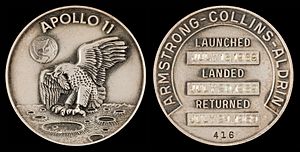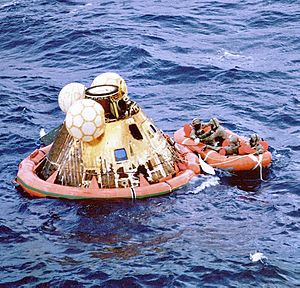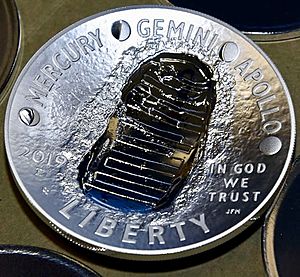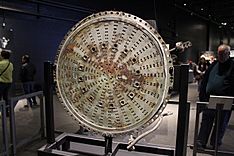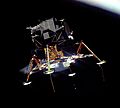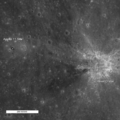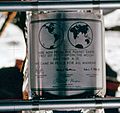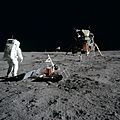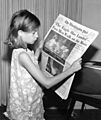Apollo 11 facts for kids
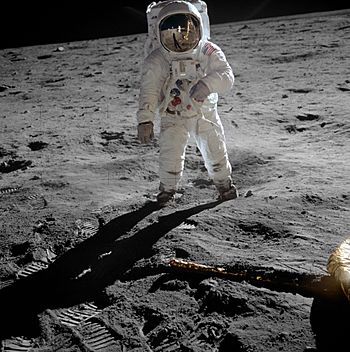
Buzz Aldrin poses on the Moon, allowing Neil Armstrong to photograph both of them using the visor's reflection.
|
|
| Mission type | Crewed lunar landing |
|---|---|
| Operator | NASA |
| Mission duration | 8 days, 3 hours, 18 minutes, 35 seconds |
| Spacecraft properties | |
| Spacecraft |
|
| Lunar orbiter | |
| Spacecraft component | Command and service module |
| Orbital insertion | July 19, 1969, 17:21:50 UTC |
| Orbital departure | July 22, 1969, 04:55:42 UTC |
| Orbits | 30 |
| Crew | |
| Crew size | 3 |
| Members | |
| Callsign |
|
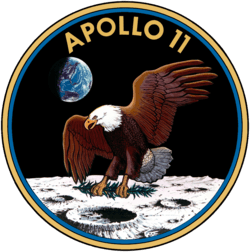 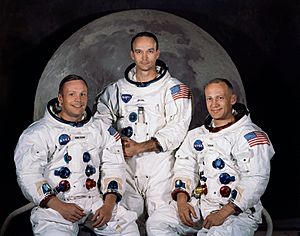 Left to right: Neil Armstrong, Michael Collins, Buzz Aldrin |
|
Apollo 11 was the first flight to send people to the moon. It was done by NASA, the American space group. It went up to space on 16 July 1969, carrying three astronauts: Neil Armstrong, Buzz Aldrin and Michael Collins. On 20 July 1969, Armstrong and Aldrin became the first humans to land on the moon, while Collins stayed in orbit around the Moon.
The flight was part of the Space Race. It finished the plan set by John F. Kennedy in 1961 to "land a man on the moon, and return him safely to the Earth", before the 1960s ended.
Contents
Preparations
Insignia
The Apollo 11 mission emblem was designed by Collins, who wanted a symbol for "peaceful lunar landing by the United States". At Lovell's suggestion, he chose the bald eagle, the national bird of the United States, as the symbol. Tom Wilson, a simulator instructor, suggested an olive branch in its beak to represent their peaceful mission. Collins added a lunar background with the Earth in the distance. The sunlight in the image was coming from the wrong direction; the shadow should have been in the lower part of the Earth instead of the left. Aldrin, Armstrong and Collins decided the Eagle and the Moon would be in their natural colors, and decided on a blue and gold border. Armstrong was concerned that "eleven" would not be understood by non-English speakers, so they went with "Apollo 11", and they decided not to put their names on the patch, so it would "be representative of everyone who had worked toward a lunar landing".
An illustrator at the Manned Spacecraft Center (MSC) did the artwork, which was then sent off to NASA officials for approval. The design was rejected. Bob Gilruth, the director of the MSC felt the talons of the eagle looked "too warlike". After some discussion, the olive branch was moved to the talons. When the Eisenhower dollar coin was released in 1971, the patch design provided the eagle for its reverse side. The design was also used for the smaller Susan B. Anthony dollar unveiled in 1979.
Call signs

The Lunar module was named Eagle after the motif which was featured prominently on the mission insignia. At Scheer's suggestion, the command module was named Columbia after Columbiad, the giant cannon that launched a spacecraft (also from Florida) in Jules Verne's 1865 novel From the Earth to the Moon. It also referred to Columbia, a historical name of the United States. In Collins' 1976 book, he said Columbia was in reference to Christopher Columbus.
Mementos
The astronauts had personal preference kits (PPKs), small bags containing personal items of significance they wanted to take with them on the mission. Five 0.5-pound (0.23 kg) PPKs were carried on Apollo 11: three (one for each astronaut) were stowed on Columbia before launch, and two on Eagle.
Neil Armstrong's LM PPK contained a piece of wood from the Wright brothers' 1903 Wright Flyer's left propeller and a piece of fabric from its wing, along with a diamond-studded astronaut pin originally given to Slayton by the widows of the Apollo 1 crew. This pin had been intended to be flown on that mission and given to Slayton afterwards, but following the disastrous launch pad fire and subsequent funerals, the widows gave the pin to Slayton. Armstrong took it with him on Apollo 11.
The Flight
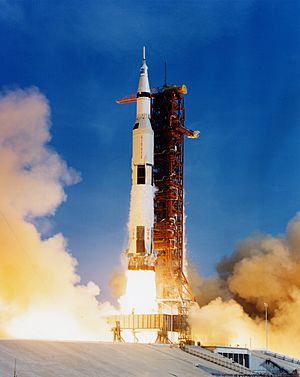
Apollo 11 was launched by a Saturn V rocket from Kennedy Space Center on Merritt Island, Florida, on July 16 at 13:32 UTC, and it was the fifth crewed mission of NASA's Apollo program. The Apollo spacecraft had three parts: a command module (CM) with a cabin for the three astronauts, the only part that returned to Earth; a service module (SM), which supported the command module with propulsion, electrical power, oxygen, and water; and a lunar module (LM) that had two stages—a descent stage for landing on the Moon and an ascent stage to place the astronauts back into lunar orbit.
After being sent to the Moon by the Saturn V's third stage, the astronauts separated the spacecraft from it and traveled for three days until they entered lunar orbit. Armstrong and Aldrin then moved into Eagle and landed in the Sea of Tranquility on July 20. During the landing there were several problems with the computer. To land safely Armstrong had to fly the Eagle himself. They landed with only 25 seconds of fuel left.
The astronauts used Eagle's ascent stage to lift off from the lunar surface and rejoin Collins in the command module. They jettisoned Eagle before they performed the maneuvers that propelled Columbia out of the last of its 30 lunar orbits onto a trajectory back to Earth. They returned to Earth and splashed down in the Pacific Ocean on July 24 after more than eight days in space.
Operations on the Moon
Preparations for Neil Armstrong and Buzz Aldrin to walk on the Moon began at 23:43 UTC. These took longer than expected; three and a half hours instead of two. During training on Earth, everything required had been neatly laid out in advance, but on the Moon the cabin contained a large number of other items as well, such as checklists, food packets, and tools. Six hours and thirty-nine minutes after landing Armstrong and Aldrin were ready to go outside, and Eagle was depressurized.
Eagle's hatch was opened at 02:39:33. Armstrong initially had some difficulties squeezing through the hatch with his portable life support system (PLSS). Some of the highest heart rates recorded from Apollo astronauts occurred during LM egress and ingress. At 02:51 Armstrong began his descent to the lunar surface.
Apollo 11 used slow-scan television (TV) incompatible with broadcast TV, so it was displayed on a special monitor and a conventional TV camera viewed this monitor (thus, a broadcast of a broadcast), significantly reducing the quality of the picture. The signal was received at Goldstone in the United States, but with better fidelity by Honeysuckle Creek Tracking Station near Canberra in Australia. Minutes later the feed was switched to the more sensitive Parkes radio telescope in Australia. Despite some technical and weather difficulties, black and white images of the first lunar EVA were received and broadcast to at least 600 million people on Earth. Copies of this video in broadcast format were saved and are widely available, but recordings of the original slow scan source transmission from the lunar surface were likely destroyed during routine magnetic tape re-use at NASA.
After describing the surface dust as "very fine-grained" and "almost like a powder", at 02:56:15, six and a half hours after landing, Armstrong stepped off Eagle's landing pad and declared: "That's one small step for [a] man, one giant leap for mankind."
About seven minutes after stepping onto the Moon's surface, Armstrong collected a contingency soil sample using a sample bag on a stick. He then folded the bag and tucked it into a pocket on his right thigh. This was to guarantee there would be some lunar soil brought back in case an emergency required the astronauts to abandon the EVA and return to the LM. Twelve minutes after the sample was collected, he removed the TV camera from the MESA and made a panoramic sweep, then mounted it on a tripod. The TV camera cable remained partly coiled and presented a tripping hazard throughout the EVA. Still photography was accomplished with a Hasselblad camera that could be operated hand-held or mounted on Armstrong's Apollo space suit. Aldrin joined Armstrong on the surface. He described the view with the simple phrase: "Magnificent desolation."
Armstrong said moving in the lunar gravity, one-sixth of Earth's, was "even perhaps easier than the simulations ... It's absolutely no trouble to walk around." Aldrin joined him on the surface and tested methods for moving around, including two-footed kangaroo hops. The PLSS backpack created a tendency to tip backward, but neither astronaut had serious problems maintaining balance. Loping became the preferred method of movement. The astronauts reported that they needed to plan their movements six or seven steps ahead. The fine soil was quite slippery. Aldrin remarked that moving from sunlight into Eagle's shadow produced no temperature change inside the suit, but the helmet was warmer in sunlight, so he felt cooler in shadow. The MESA failed to provide a stable work platform and was in shadow, slowing work somewhat. As they worked, the moonwalkers kicked up gray dust, which soiled the outer part of their suits.
The astronauts planted the Lunar Flag Assembly containing a flag of the United States on the lunar surface, in clear view of the TV camera. Aldrin remembered, "Of all the jobs I had to do on the Moon the one I wanted to go the smoothest was the flag raising." But the astronauts struggled with the telescoping rod and could only insert the pole about 2 inches (5 cm) into the hard lunar surface. Aldrin was afraid it might topple in front of TV viewers, but gave "a crisp West Point salute". Before Aldrin could take a photo of Armstrong with the flag, President Richard Nixon spoke to them through a telephone-radio transmission, which Nixon called "the most historic phone call ever made from the White House." Nixon originally had a long speech prepared to read during the phone call, but Frank Borman, who was at the White House as a NASA liaison during Apollo 11, convinced Nixon to keep his words brief.
Nixon: Hello, Neil and Buzz. I'm talking to you by telephone from the Oval Room at the White House. And this certainly has to be the most historic telephone call ever made from the White House. I just can't tell you how proud we all are of what you have done. For every American, this has to be the proudest day of our lives. And for people all over the world, I am sure that they too join with Americans in recognizing what an immense feat this is. Because of what you have done, the heavens have become a part of man's world. And as you talk to us from the Sea of Tranquility, it inspires us to redouble our efforts to bring peace and tranquility to Earth. For one priceless moment in the whole history of man, all the people on this Earth are truly one: one in their pride in what you have done, and one in our prayers that you will return safely to Earth.
Armstrong: Thank you, Mr. President. It's a great honor and privilege for us to be here, representing not only the United States, but men of peace of all nations, and with interest and a curiosity, and men with a vision for the future. It's an honor for us to be able to participate here today.
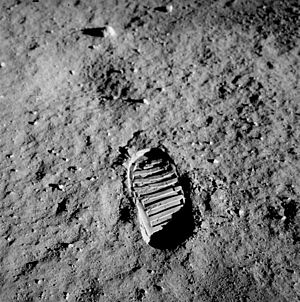
They deployed the EASEP, which included a passive seismic experiment package used to measure moonquakes and a retroreflector array used for the lunar laser ranging experiment. Then Armstrong walked 196 feet (60 m) from the LM to take photographs at the rim of Little West Crater while Aldrin collected two core samples. He used the geologist's hammer to pound in the tubes—the only time the hammer was used on Apollo 11—but was unable to penetrate more than 6 inches (15 cm) deep. The astronauts then collected rock samples using scoops and tongs on extension handles. Many of the surface activities took longer than expected, so they had to stop documenting sample collection halfway through the allotted 34 minutes. Aldrin shoveled 6 kilograms (13 lb) of soil into the box of rocks in order to pack them in tightly. Two types of rocks were found in the geological samples: basalt and breccia. Three new minerals were discovered in the rock samples collected by the astronauts: armalcolite, tranquillityite, and pyroxferroite. Armalcolite was named after Armstrong, Aldrin, and Collins. All have subsequently been found on Earth.
While on the surface, Armstrong uncovered a plaque mounted on the LM ladder, bearing two drawings of Earth (of the Western and Eastern Hemispheres), an inscription, and signatures of the astronauts and President Nixon. The inscription read:
Here men from the planet Earth first set foot upon the Moon July 1969, A. D. We came in peace for all mankind.
At the behest of the Nixon administration to add a reference to God, NASA included the vague date as a reason to include A.D., which stands for Anno Domini ("in the year of our Lord").
Leaving the moon and returning to Earth
After finishing their work, Armstrong and Aldrin returned to the Eagle and slept for seven hours before starting to leave. While preparing to leave, Aldrin broke the circuit breaker in the engine starter. Armstrong used a pen to bridge the circuit and stop them from being stuck on the moon. Aldrin and Armstrong left many things on the moon: an American flag, a few experiments, a golden feather, a logo of Apollo 1 and some bronze coins honoring Yuri Gagarin and Vladimir Komarov. He also left a sign on the moon, with a message from the human race. The sign reads:
Here men from the planet Earth first set foot upon the Moon, July 1969 A.D. We came in peace for all mankind.
On July 24 the three astronauts returned to Earth and were immediately placed into quarantine (kept away from other people), in case they brought back some disease from the moon. They stayed in quarantine for three weeks. When they got out the men were heroes around the world. They had dinner with President Nixon, a parade in New York City and another one in Chicago. The three were also on many television shows.
50th anniversary events
On June 10, 2015, Congressman Bill Posey introduced resolution H.R. 2726 to the 114th session of the United States House of Representatives directing the United States Mint to design and sell commemorative coins in gold, silver and clad for the 50th anniversary of the Apollo 11 mission. On January 24, 2019, the Mint released the Apollo 11 Fiftieth Anniversary commemorative coins to the public on its website.
A documentary film, Apollo 11, with restored footage of the 1969 event, premiered in IMAX on March 1, 2019, and broadly in theaters on March 8.
Beginning July 9, 2019, PBS aired a three-night, six-hour documentary, called Chasing the Moon, which examined the events leading up to Apollo 11. An accompanying book of the same name was also released.
Cultural significance
Humans walking on the Moon and returning safely to Earth accomplished Kennedy's goal set eight years earlier. In Mission Control during the Apollo 11 landing, Kennedy's speech flashed on the screen, followed by the words "TASK ACCOMPLISHED, July 1969".
The success of Apollo 11 demonstrated the United States' technological superiority; and with the success of Apollo 11, America had won the Space Race.
New phrases appeared in the English language. "If they can send a man to the Moon, why can't they ...?" became a common saying following Apollo 11. Armstrong's words on the lunar surface also spun off various parodies.
Spacecraft
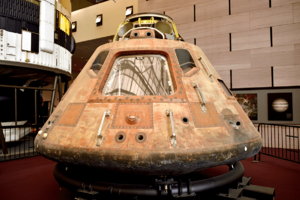
The command module Columbia went on a tour of the United States, visiting 49 state capitals, the District of Columbia, and Anchorage, Alaska. In 1971, it was transferred to the Smithsonian Institution, and was displayed at the National Air and Space Museum (NASM) in Washington, DC. It was in the central Milestones of Flight exhibition hall in front of the Jefferson Drive entrance, sharing the main hall with other pioneering flight vehicles such as the Wright Flyer, Spirit of St. Louis, Bell X-1, North American X-15 and Friendship 7.
Columbia was moved in 2017 to the NASM Mary Baker Engen Restoration Hangar at the Steven F. Udvar-Hazy Center in Chantilly, Virginia, to be readied for a four-city tour titled Destination Moon: The Apollo 11 Mission. This included Space Center Houston from October 14, 2017, to March 18, 2018, the Saint Louis Science Center from April 14 to September 3, 2018, the Senator John Heinz History Center in Pittsburgh from September 29, 2018, to February 18, 2019, and its last location at Museum of Flight in Seattle from March 16 to September 2, 2019. Continued renovations at the Smithsonian allowed time for an additional stop for the capsule, and it was moved to the Cincinnati Museum Center. The ribbon cutting ceremony was on September 29, 2019.
For 40 years Armstrong's and Aldrin's space suits were displayed in the museum's Apollo to the Moon exhibit, until it permanently closed on December 3, 2018, to be replaced by a new gallery which was scheduled to open in 2022. A special display of Armstrong's suit was unveiled for the 50th anniversary of Apollo 11 in July 2019. The quarantine trailer, the flotation collar and the flotation bags are in the Smithsonian's Steven F. Udvar-Hazy Center annex near Washington Dulles International Airport in Chantilly, Virginia, where they are on display along with a test lunar module.
The descent stage of the LM Eagle remains on the Moon. In 2009, the Lunar Reconnaissance Orbiter (LRO) imaged the various Apollo landing sites on the surface of the Moon, for the first time with sufficient resolution to see the descent stages of the lunar modules, scientific instruments, and foot trails made by the astronauts. The remains of the ascent stage lie at an unknown location on the lunar surface, after being abandoned and impacting the Moon. The location is uncertain because Eagle ascent stage was not tracked after it was jettisoned, and the lunar gravity field is sufficiently non-uniform to make the orbit of the spacecraft unpredictable after a short time.
In March 2012 a team of specialists financed by Amazon founder Jeff Bezos located the F-1 engines from the S-IC stage that launched Apollo 11 into space. They were found on the Atlantic seabed using advanced sonar scanning. His team brought parts of two of the five engines to the surface. In July 2013, a conservator discovered a serial number under the rust on one of the engines raised from the Atlantic, which NASA confirmed was from Apollo 11. The S-IVB third stage which performed Apollo 11's trans-lunar injection remains in a solar orbit near to that of Earth.
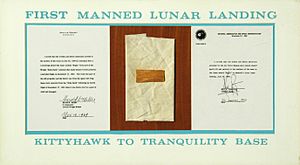
Moon rocks
The main repository for the Apollo Moon rocks is the Lunar Sample Laboratory Facility at the Lyndon B. Johnson Space Center in Houston, Texas. For safekeeping, there is also a smaller collection stored at White Sands Test Facility near Las Cruces, New Mexico. Most of the rocks are stored in nitrogen to keep them free of moisture. They are handled only indirectly, using special tools. Over 100 research laboratories worldwide conduct studies of the samples; approximately 500 samples are prepared and sent to investigators every year.
In November 1969, Nixon asked NASA to make up about 250 presentation Apollo 11 lunar sample displays for 135 nations, the fifty states of the United States and its possessions, and the United Nations. Each display included Moon dust from Apollo 11 and flags, including the one of the Soviet Union, taken along by Apollo 11. The rice-sized particles were four small pieces of Moon soil weighing about 50 mg and were enveloped in a clear acrylic button about as big as a United States half dollar coin. This acrylic button magnified the grains of lunar dust. Nixon gave the Apollo 11 lunar sample displays as goodwill gifts in 1970.
Interesting facts about the Apollo 11 mission
- Armstrong's Hasselblad camera was thought to be lost or left on the Moon surface.
- In 2015, after Armstrong died in 2012, his widow found a white cloth bag in one of Armstrong's closets. The bag contained various items, which should have been left behind in the lunar module, including the 16mm Data Acquisition Camera that had been used to capture images of the first Moon landing. The camera is currently on display at the National Air and Space Museum.
- During Projects Mercury and Gemini, each mission had a prime and a backup crew. For Apollo, a third crew of astronauts was added, known as the support crew. For Apollo 11, the support crew consisted of Ken Mattingly, Ronald Evans and Bill Pogue.
- Twenty percent of the world's population watched humans walk on the Moon for the first time.
- The Apollo 11 landing is referenced in the songs "Armstrong, Aldrin and Collins" by The Byrds on the 1969 album Ballad of Easy Rider and "Coon on the Moon" by Howlin' Wolf on the 1973 album The Back Door Wolf.
- The descent stage of the LM Eagle remains on the Moon. In 2009, the Lunar Reconnaissance Orbiter (LRO) imaged the various Apollo landing sites on the surface of the Moon, for the first time with sufficient resolution to see the descent stages of the lunar modules, scientific instruments, and foot trails made by the astronauts.
- Armstrong intended to say "That's one small step for a man", but the word "a" is not audible in the transmission, and thus was not initially reported by most observers of the live broadcast. When later asked about his quote, Armstrong said he believed he said "for a man", and subsequent printed versions of the quote included the "a" in square brackets.
Related pages
Images for kids
-
President John F. Kennedy speaking at Rice University on September 12, 1962
-
CAPCOM Charles Duke (left), with backup crewmen Jim Lovell and Fred Haise listening in during Apollo 11's descent
-
Saturn V SA-506, the rocket carrying the Apollo 11 spacecraft, moves out of the Vehicle Assembly Building towards Launch Complex 39
-
A girl holding The Washington Post newspaper stating "'The Eagle Has Landed' – Two Men Walk on the Moon"
-
Saturn V rocket projected onto the Washington Monument during the Apollo 11 50th anniversary show
See also
 In Spanish: Apolo 11 para niños
In Spanish: Apolo 11 para niños


